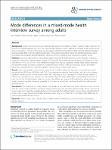Mode differences in a mixed-mode health interview survey among adults
Hoebel, Jens
Lippe, Elena von der
Lange, Cornelia
Ziese, Thomas
Background: Health interview surveys are important data sources for empirical research in public health. However, the diversity of methods applied, such as in the mode of data collection, make it difficult to compare results across surveys, time, or countries. The aim of this study was to explore whether the prevalence rates of health-related indicators amongst adults differ when self-administered paper mail questionnaires (SAQ-Paper), self-administered web surveys (SAQ-Web), and computer-assisted telephone interviews (CATI) are used for data collection in a health survey. Methods: Data were obtained from a population-based mixed-mode health interview survey of adults in Germany carried out within the ‘German Health Update’ (GEDA) study. Data were collected either by SAQ-Paper (n = 746), SAQ-Web (n = 414), or CATI (n = 411). Predictive margins from logistic regression models were used to estimate the prevalence rates of chronic conditions, subjective health, mental health, psychosocial factors, and health behaviours, adjusted for the socio-demographic characteristics of each mode group. Results: Socio-demographic characteristics were found to differ significantly between study participants who responded by SAQ-Paper, SAQ-Web, and CATI. Crude prevalence rates for health-related indicators also showed significant variation across all three survey modes. After adjusting for socio-demographic factors though, significant differences in prevalence rates between the two self-administered modes (SAQ-Paper and SAQ-Web) were found in only 2 out of the 19 health-related indicators studied. The differences between CATI and the two self-administered modes remained significant however, especially for indicators of mental and psychosocial health and self-reported sporting activity. Conclusions: The findings of this study indicate that prevalence rates obtained from health interview surveys can vary with the mode of data collection, primarily between interviewer and self-administered modes. Hence, the type of survey mode used should be considered when comparing results from different health surveys. Mixing self-administered modes, such as paper-based questionnaires and web surveys, may be a combination to minimize mode differences in mixed-mode health interview surveys.
Dateien zu dieser Publikation
Keine Lizenzangabe

